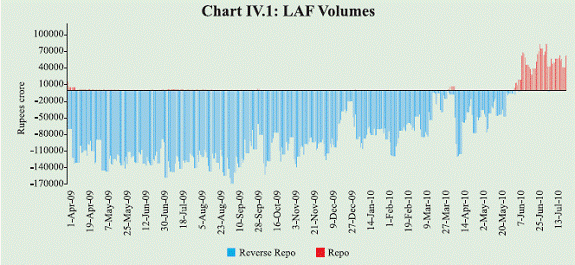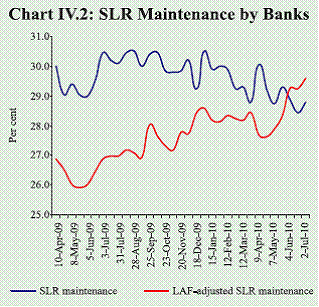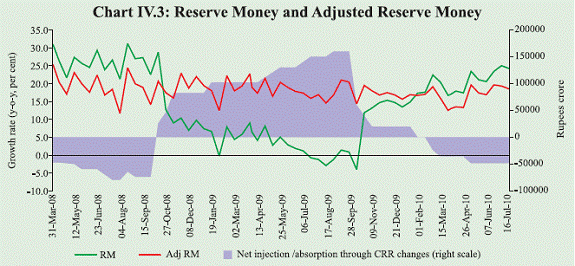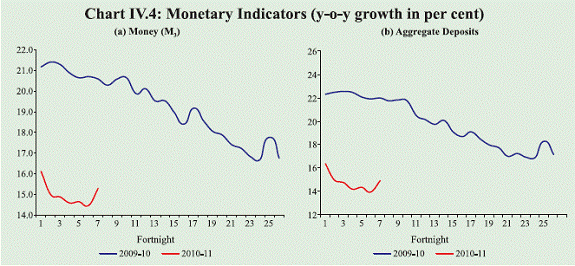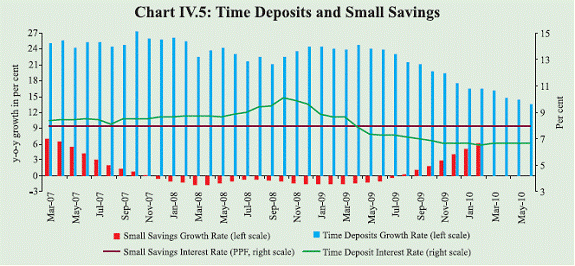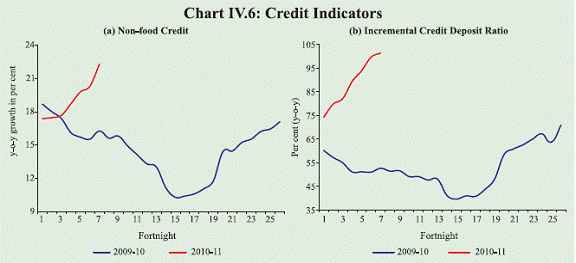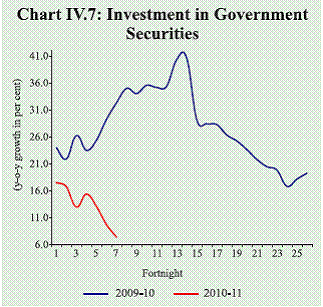IV. Monetary Conditions - ஆர்பிஐ - Reserve Bank of India
IV. Monetary Conditions
Reflecting the calibrated monetary exit, the magnitude of the surplus liquidity in the system moderated gradually. In June 2010, however, there was a severe tightness in liquidity caused by the increase in Government's surplus balances with the Reserve Bank due to sharply higher mobilisation under 3G and BWA spectrum auctions. The liquidity situation was effectively managed by the Reserve Bank, which helped avoid spillover to overall term structure of the interest rate. During the first quarter of 2010-11, credit growth to the private sector picked up further reflecting strong recovery as also payments towards 3G and BWA spectrum. Broad money growth, however, was lower due to slowdown in the growth of deposits. IV.1 The Reserve Bank has been normalising the monetary policy instruments, i.e., the policy rates and the cash reserve ratio (CRR), since the fourth quarter of 2009-10, through a process of calibrated exit from the accommodative monetary policy stance that it had adopted in response to the global crisis. The CRR hikes effected since February 2010 helped in reducing the excess liquidity in the system. The comfortable liquidity situation turned into a deficit fairly rapidly by end-May 2010 due to an increase in currency with the public and build-up of government cash balances. IV.2 Non-food credit growth of scheduled commercial banks (SCBs) showed acceleration and by the first quarter of 2010-11 crossed the indicative growth trajectory of 20.0 per cent for the year, as set out in the Monetary Policy Statement for 2010-11. Besides strong economic activity, credit raised by telecom companies to pay for the 3G and broadband wireless access (BWA) spectrum contributed to the high rate of credit growth observed during the quarter. Money supply (M3) growth, however, was below the indicative trajectory of 17.0 per cent, set out in April 2010. The deceleration was largely on account of the slowdown in the growth rate of aggregate deposits with banks (Table IV.1).
Liquidity Management IV.3 The liquidity conditions changed significantly during the first quarter of 2010-11. The gradual moderation in the volume of surplus liquidity in the system since February 2010 reflected the calibrated normalisation of the monetary policy by the Reserve Bank. Accordingly, the liquidity adjustment facility (LAF) remained in the absorption mode, though the reverse repo volumes declined gradually (Chart IV.1). From end-May 2010, there was a sudden and sharp tightening of liquidity, which was reflected in the reversal of LAF to injection mode. The liquidity tightness was caused by the large increase in government’s cash balances with the Reserve Bank, reflecting proceeds from 3G/BWA spectrum auctions, besides the first instalment of advance tax payments. IV.4 In terms of specific aspects of the evolution of liquidity conditions, the scale of surplus liquidity in the system increased initially at the commencement of the financial year 2010-11 on account of higher government expenditure. The average daily absorption under the LAF increased to Rs.57,150 crore in April 2010 from Rs.37,640 crore in March 2010. With the recovery of the economy firmly in place, the Reserve Bank moved in a calibrated manner in the direction of normalising its policy instruments. To anchor inflation and to prevent further build up of inflationary pressure, the Reserve Bank increased the repo and reverse repo rates as well as the CRR by 25 basis points each in April 2010 in the Annual Monetary Policy for 2010-11 (Table IV.2). The surplus liquidity in the domestic market gradually declined thereafter. The Reserve Bank auctioned cash management bills in May 2010 (which matured in mid-June 2010) to meet the temporary cash flow mismatches of the government. The liquidity conditions, however, changed to injection mode from May 31, 2010 due to sharp increase in government balances with the Reserve Bank, on account of higher than anticipated mobilisation under 3G/BWA spectrum auctions.
IV.5 In anticipation of temporary tightening of liquidity conditions, the Reserve Bank introduced measures allowing SCBs to avail additional liquidity support under the LAF to the extent of up to 0.5 per cent of their NDTL and also access to second LAF on a daily basis for the period May 28-July 2, 2010. The average daily injection under the LAF during June 2010 was around Rs.47,000 crore in contrast to the average daily absorption of around Rs.33,000 crore in May 2010. Consequently, the call rate moved up significantly, resulting in an effective tightening at the short end of the yield curve. The call rate, however, remained around the ceiling of the LAF corridor set by the repo rate. IV.6 Overall, increase in currency with the public and centre’s surplus balances with the Reserve Bank, both representing withdrawal of liquidity from the system, were the key drivers of autonomous liquidity in Q1 of 2010-11 (Table IV.3). Due to the increase in CRR, there was an additional withdrawal of liquidity, over and above the autonomous impact. The liquidity situation was managed primarily through LAF by injecting liquidity through repo operations (Table IV.4). IV.7 Excess SLR investments of SCBs amounted to Rs.1,87,705 crore, as on July 2, 2010, compared with Rs.2,85,491 crore a year ago. Adjusted for LAF collateral securities on an outstanding basis, given the repo mode of the LAF, SCBs’ maintenance of SLR was 29.6 per cent of NDTL, an excess of 4.6 percentage points over the prescribed SLR (Chart IV.2). The banking system has used a part of the excess SLR securities to access liquidity from the Reserve Bank through repo, and the large availability of excess SLR securities should help in avoiding spillover of tight temporary liquidity conditions to the term structure of the interest rate. Debt buy-back conducted in June 2010 and cancellation of Treasury Bill auctions in June and July 2010, also helped to an extent in alleviating the liquidity pressure. IV.8 On July 2, 2010, the repo and reverse repo rates were further raised by 25 basis points each to 5.5 per cent and 4.0 per cent, respectively, on account of developments on the inflation front, given that the upside bias to growth projection that was highlighted in the Annual Monetary Policy had materialised. The liquidity management measures, introduced earlier on an ad hoc basis were also extended up to July 16, 2010. It was clarified that the temporary measures to ease the liquidity pressures were consistent with the overall calibrated monetary exit, which aimed at containing inflation and anchoring inflation expectations without hurting growth. On an assessment of the prevailing overall liquidity conditions and with a view to providing flexibility to SCBs and primary dealers in their liquidity management, the Reserve Bank further extended the second LAF on a daily basis till July 30, 2010. The deficit liquidity conditions have continued in July 2010 so far, and the average daily injection of liquidity during the first three weeks of the month was around Rs.53,000 crore.
Reserve Money IV.9 In 2009-10, the acceleration in the growth rate of reserve money was primarily on account of increase in bankers’ deposits with the Reserve Bank on the components side of reserve money, due to cumulative increase in CRR by 75 basis points during the year. On the sources side, the increase in Reserve Bank’s credit to the centre was a major factor, which reflected the liquidity management operations of the Reserve Bank (i.e., MSS unwinding and de-sequestering, open market purchases and LAF operations) to facilitate smooth completion of the large government borrowing programme for 2009-10, while ensuring adequate financing for productive activities and containing inflationary pressures. IV.10 During the first quarter of 2010-11, the main component of increase in reserve money was currency in circulation (Table IV.5). The higher growth in currency was mainly on account of the increase in demand associated with the strong rebound in economic activities as well as the spurt in inflation. On the sources side, the increase in reserve money was led by increase in Reserve Bank’s credit to the centre, primarily reflecting the repo operations in the market1 , and unwinding of balances under the MSS. This was partially offset by the increase in government’s cash balances with the Reserve Bank. The net foreign exchange assets of the Reserve Bank also increased during the quarter.
IV.11 Since bankers’ deposits with the Reserve Bank, a key determinant of reserve money on the components side, change in response to variations in CRR effected by the Reserve Bank as a part of its monetary policy actions, it is useful to analyse the behaviour of base money adjusted for the CRR changes. The adjusted reserve money increased by 18.5 per cent (y-o-y) as on July 16, 2010, reflecting the impact of increase in currency in circulation (on the components side) and Reserve Bank credit to the government (on the sources side) (Chart IV.3). Money Supply IV.12 The deceleration in the growth of M3 continued up to mid-June 2010 (Chart IV.4 a). This was on account of the deceleration of its major component, i.e., aggregate deposits (Table IV.6 and Chart IV.4 b). The moderation in the growth of time deposits was particularly sharp, which was partly a response to the low deposit rates, given high inflation. During the fortnight ended July 2, 2010, aggregate deposits registered a fortnightly increase of about Rs.1,15,000 crore; it is likely that the increased off-take of credit has begun to be reflected in deposit growth. There has been an increased inflow into small savings schemes since August 2009 as returns on investments in small savings have been higher than on time deposits with banks since the beginning of 2009-10 (Chart IV.5). Total incremental inflows into small savings are, however, a small fraction of monthly increases in time deposits, notwithstanding the deceleration in the growth of time deposits.
IV.13 As regards sources of M3, the increase in money supply during the quarter came mainly from banking system’s credit to the commercial sector. There has been sustained acceleration in growth of non-food credit extended by SCBs since the last quarter of 2009-10 (Chart IV.6 a). Telecom operators raised credit to pay for the 3G/ BWA spectrums, which partly contributed to the stronger growth in credit. With tepid deposit mobilisation (barring the fortnight ending on July 2, 2010), the incremental non-food credit deposit ratio of SCBs moved up to over 100 per cent (Chart IV.6 b). On outstanding basis though, the non-food credit to deposit ratio was 72.3 per cent on July 2, 2010.
IV.14 Given the deceleration in deposits and acceleration in the growth of non-food credit, there has been a deceleration in banks’ investment in government securities since November 2009, which is the time when growth in non-food credit turned around (Chart IV.7). IV.15 The revival in credit demand was reflected in the lending figures for all bank groups, with foreign banks and private sector banks in particular, showing significant improvement in their y-o-y credit growth compared to last year (Table IV.7). Credit growth from the public sector banks continued to be the highest and also most stable.
IV.16 Disaggregated data on sectoral deployment of gross bank credit show improvement in credit growth (y-o-y) to industry, though the flow is yet not broadbased (Table IV.8). Industry absorbed 57.9 per cent of incremental non-food credit (y-o-y) in May 2010 as compared with 47.4 per cent in the corresponding month of the previous year. This expansion was led by infrastructure, textiles, food processing, paper and paper products, petroleum, coal products and nuclear fuels, chemicals and chemical products, and vehicles, vehicle parts and transport equipments. The share of incremental non-food credit to micro and small enterprises (industry as well as services), however, declined to 11.9 per cent in May 2010 as compared with 16.0 per cent in May 2009. Within services sector, credit to real estate decelerated sharply, reflecting definitional change to the concept of “lending to real estate sector” effected in September 2009. IV.17 Banking system accounted for roughly 65 per cent of the total flow of financing to the commercial sector during the first quarter of 2010-11, even as the flow from non-bank sources also increased significantly over the corresponding period of the previous year. Besides bank credit, issuance of IPOs, credit from housing finance companies, external commercial borrowings and ADRs/GDRs were the other important sources of finance for the commercial sector (Table IV.9).
IV.18 Reflecting the strong growth momentum and sharp acceleration in investment demand, credit to the private sector recovered significantly. Flow of resources from non-banks also increased to meet the financing needs of the private sector. Broad money growth remained below the trajectory envisaged by the Monetary Policy Statement for 2010-11, largely due to the deceleration in the growth of aggregate deposits up to mid-June 2010. There has been a turnaround in the growth of both broad money and deposits, which though coincided with a period of pick-up in credit to telecom companies and the switchover to the base rate. The tightness in liquidity conditions would ease, but the calibrated normalisation of monetary policy may not lead to return of the persistent easy liquidity conditions that prevailed last year. Banks, therefore, have to step-up mobilisation of deposits to meet the demand for credit from both the private sector and the government. 1 The Reserve Bank’s credit to the Centre is affected by LAF operations, OMO, MSS balances and Government’s cash surplus with the Reserve Bank. Increase in repo/OMO purchases and decline in reverse repo/MSS balances/Government’s surplus balances with Reserve Bank lead to increase in net Reserve Bank credit to the Centre, and vice versa. |
||||||||||||||||||||||||||||||||||||||||||||||||||||||||||||||||||||||||||||||||||||||||||||||||||||||||||||||||||||||||||||||||||||||||||||||||||||||||||||||||||||||||||||||||||||||||||||||||||||||||||||||||||||||||||||||||||||||||||||||||||||||||||||||||||||||||||||||||||||||||||||||||||||||||||||||||||||||||||||||||||||||||||||||||||||||||||||||||||||||||||||||||||||||||||||||||||||||||||||||||||||||||||||||||||||||||||||||||||||||||||||||||||||||||||||||||||||||||||||||||||||||||||||||||||||||||||||||||||||||||||||||||||||||||||||||||||||||||||||||||||||||||||||||||||||||||||||||||||||||||||||||||||||||||||||||||||||||||||||||||||||||||||||||||||||||||||||||||||||||||||||||||||||||||||||||||||||||||||||||||||













